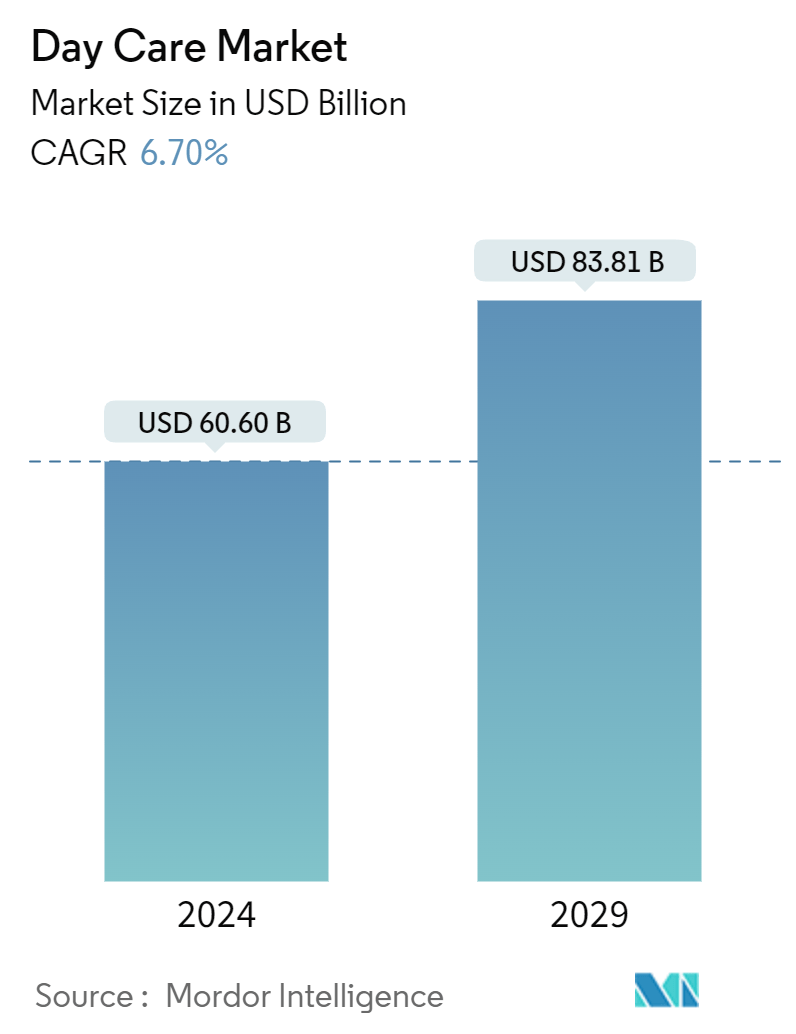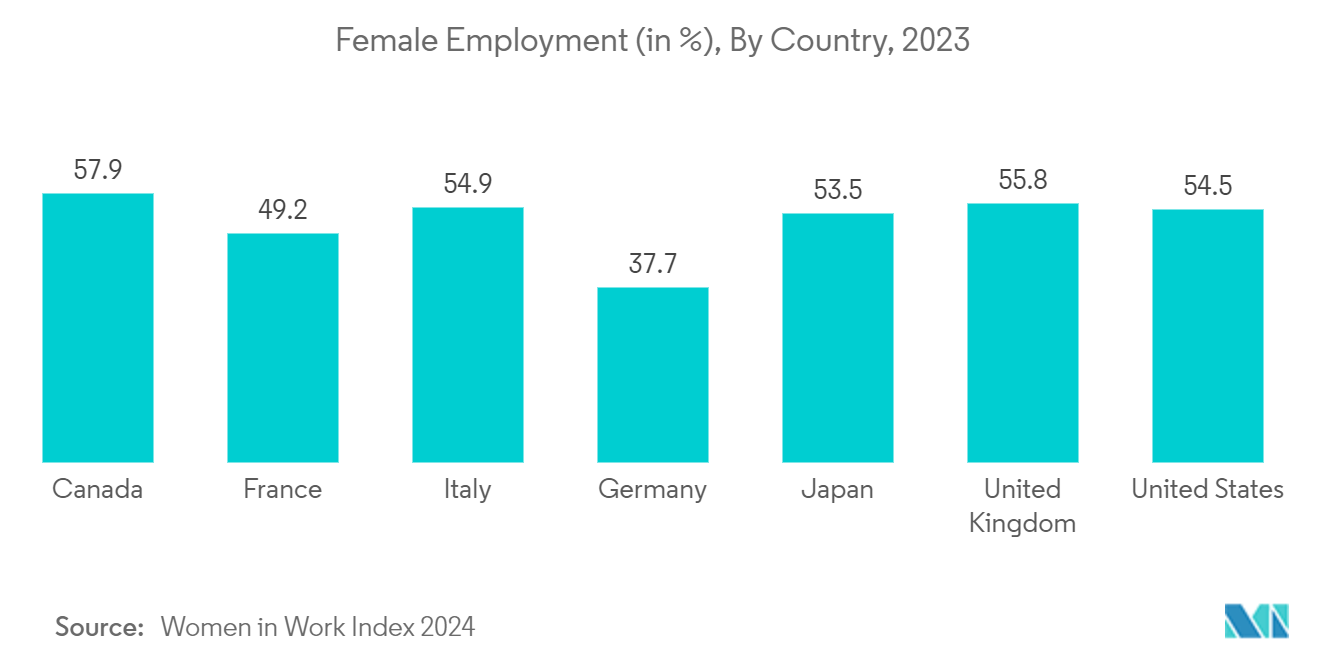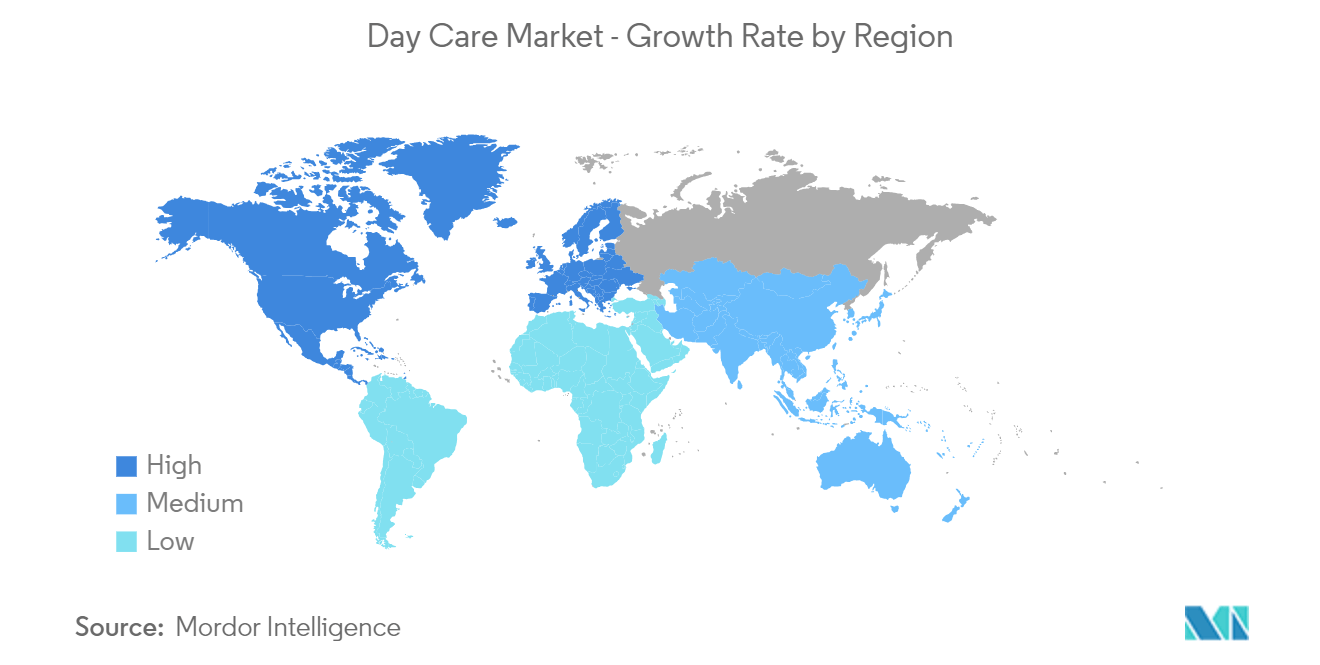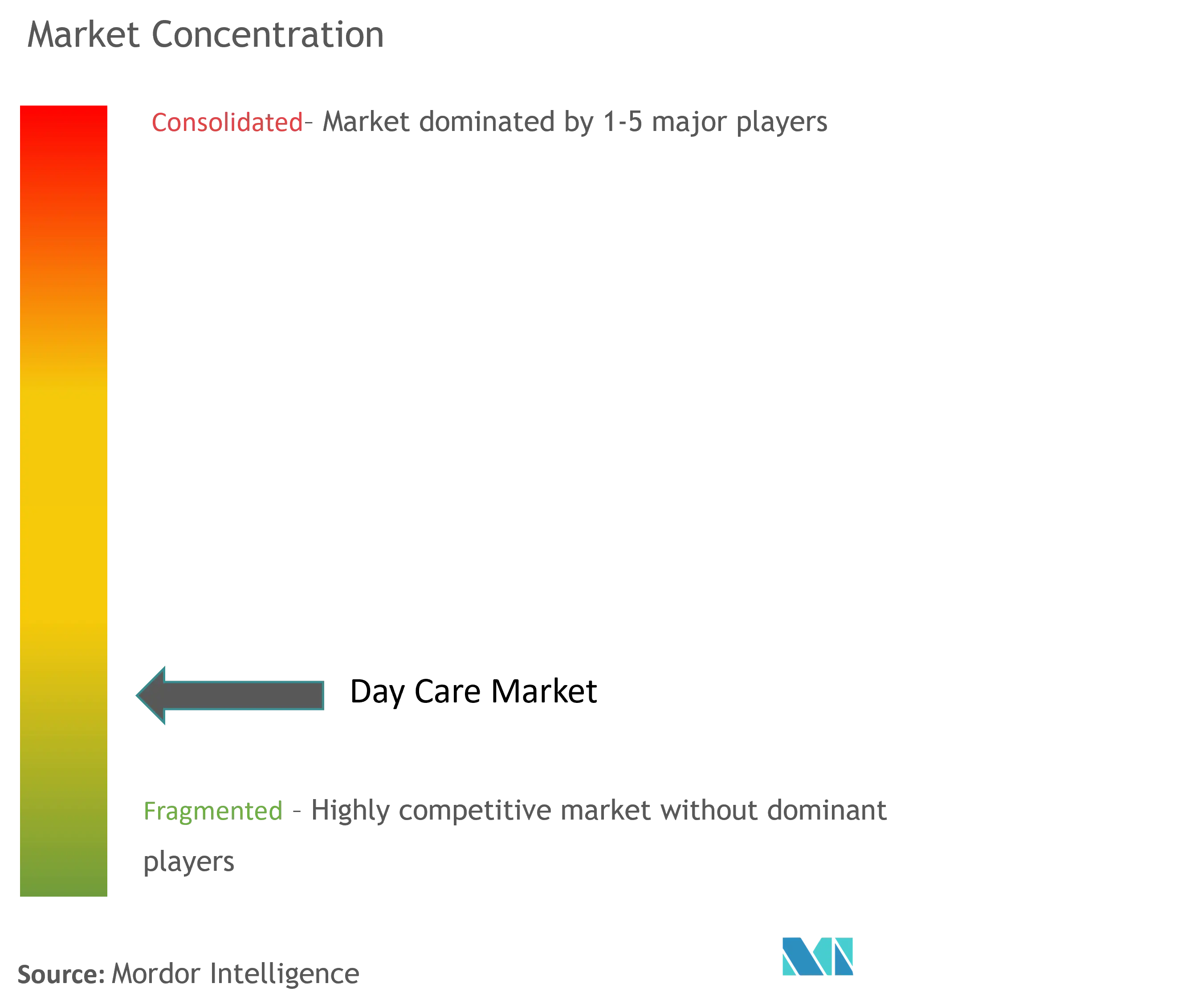Day Care Market Size

| Study Period | 2019 - 2029 |
| Market Size (2024) | USD 60.60 Billion |
| Market Size (2029) | USD 83.81 Billion |
| CAGR (2024 - 2029) | 6.70 % |
| Fastest Growing Market | Asia Pacific |
| Largest Market | North America |
Major Players
*Disclaimer: Major Players sorted in no particular order |
Day Care Market Analysis
The Day Care Market size is estimated at USD 60.60 billion in 2024, and is expected to reach USD 83.81 billion by 2029, growing at a CAGR of 6.70% during the forecast period (2024-2029).
The growing number of working parents and increasing awareness about early childhood education are significantly driving the market growth for day care services. As more families rely on dual incomes, the demand for reliable and high-quality childcare solutions has surged, prompting a rise in day care facilities. Additionally, heightened awareness of the importance of early childhood education for cognitive and social development has led parents to seek out day care centers that offer structured learning environments and developmental programs.
More parents are working full-time or part-time, necessitating reliable childcare solutions during work hours. This shift creates a higher demand for day care services as parents need safe, professional environments where their children can be cared for while at work. It drives the growth of the daycare market by increasing the need for more facilities, flexible hours, and diverse care options. For instance, as per Statistics Canada, in December 2023, 30.1% of parents with at least one child aged five or younger worked exclusively from home or followed a hybrid work model. Among these parents, 33.2% were mothers and 27.4% were fathers, underscoring the allure of flexible work setups for families. As a result, day care providers are expanding their services and increasing their capacity to meet the increasing demand, thereby boosting the market's growth.
There is increasing recognition of the importance of early childhood education for a child's long-term cognitive, social, and emotional development. Research highlights that early learning experiences can significantly impact academic success and social skills. Initiatives aimed at raising awareness about the benefits of early childhood education are becoming more prevalent. For example, in January 2023, the Shaping Us Campaign launched in the United Kingdom underscores the pivotal role of early childhood in influencing both individual trajectories and societal outcomes. The campaign informs the public on how early experiences mold children's futures and actively promotes community involvement to bolster families during these crucial developmental stages. This awareness influences parents to seek day care centers that offer educational programs, structured activities, and developmental milestones, thus expanding the market and encouraging investment in high-quality, educational day care services.
The launch of these day care services and initiatives reflects a growing commitment to improving early childhood education and supporting working parents and is anticipated to bolster the market's growth. For instance, in March 2024, Hyundai Motor Manufacturing Alabama introduced a child care initiative to enhance access to child care services for its employees. In collaboration with TOOTRiS, a child care technology platform, the initiative offers employees a stipend that covers 25% of their monthly childcare expenses, capped at USD 150. This program aims to bolster employee retention and tackle the difficulties of securing affordable child care in Alabama. Thus, these programs aim to address the challenges faced by families and promote better outcomes for children, driving the market's growth.
Higher parental workforce participation and a greater emphasis on early childhood education are propelling the demand for day care services, leading to a robust growth in the market and a broader range of service offerings. However, the high cost of day care services and regulatory and licensing challenges hamper the market's growth.
Day Care Market Trends
The Center Based Segment is Expected to Hold a Significant Share in the Market During the Forecast Period
The center-based segment is experiencing significant growth driven by increased workforce participation, as more parents, particularly mothers, are entering the job market and require reliable childcare. Additionally, there is a growing emphasis on early childhood education, prompting parents to seek programs that offer structured learning environments. Government support, including funding and regulatory improvements, is enhancing the accessibility and quality of these services.
Center-based day care offers several advantages over home-based care, including structured learning environments that promote early childhood education and development. Children benefit from regular social interaction with peers, fostering essential social skills. Many centers employ qualified staff and adhere to strict health and safety regulations, providing greater reassurance to parents.
For instance, as per the Federal Statistical Office (Destatis), as of March 2022, 75% of mothers were employed in Germany, and their share increased by 5% points within the last ten years. Thus, the increasing number of working mothers is anticipated to bolster the demand for center-based care, driving the segment's growth.
Positive government initiatives, including increased funding for early childhood education and quality standards, create a favorable environment for center-based day care growth. These initiatives help reduce financial burdens on families, making quality childcare more accessible. For instance, in February 2023, with a USD 30 million investment, the United States Department of Health and Human Services (HHS) inaugurated the inaugural National Early Care and Education Workforce Center. This center is dedicated to bolstering research, offering technical assistance, and advancing workforce development for early childhood education professionals, with the overarching goal of elevating the quality of care in day care settings.
Additionally, the expansion of day care centers is expected to boost the market's growth. For instance, in April 2023, KLAY Preschool and Daycare, the largest chain of its kind in India, expanded its footprint to 400 centers. The focus is on tier II cities, and the chain is collaborating with over 420 corporates to assist working mothers. This move aligns with KLAY's mission to ease women's transition back into the workforce by offering dependable day care services. Thus, center-based facilities often serve as community hubs, offering resources and support for families, making them an appealing choice for parents seeking high-quality care, thereby boosting the market's growth.

North America is Expected to Hold a Significant Share in the Market During the Forecast Period
The North American day care market is experiencing significant growth driven by several key factors. Increased workforce participation, particularly among mothers, has heightened the demand for reliable childcare solutions. Additionally, a growing recognition of the importance of early childhood education has led parents to seek high-quality programs that promote cognitive and social development. Government initiatives and funding to improve childcare accessibility and quality further bolster this demand.
As more parents, especially mothers, join the workforce, the demand for reliable childcare options has surged. For instance, as per the Bureau of Labor Statistics, in March 2024, at least one parent was employed in 91.9% of families with children in 2023, marking an uptick from 91.2% in 2022. The participation rate for mothers with children under 18 climbed to 74.0%, a rise of 1.1% points from the prior year. Specifically, among mothers with children under 6, the participation rate stood at 68.9%. This rate saw a notable increase to 77.8% for mothers with children aged 6 to 17. Meanwhile, the participation rate for fathers with children under 18 increased from 92.9% in 2022 to 93.4% in 2023. This trend creates a greater need for day care services, leading to market expansion as providers work to meet the rising demand, thereby boosting the market's growth.
Many governments in North America are implementing policies to support and subsidize childcare services, making them accessible and affordable for families. For instance, as per the data published by the Government of Canada in May 2024, the Canadian government rolled out a national early learning and child care (CWELCC) system. This initiative seeks to offer affordable, adaptable, and top-notch child care throughout the provinces and territories. By 2026, the program aims to slash average fees for regulated child care to just USD 10 a day, a move poised to benefit families with young children. These initiatives encourage the establishment of new day care centers and improve existing facilities, boosting the market's growth.
Moreover, many day care centers are evolving into community hubs that offer resources and support for families. This added value enhances the attractiveness of these facilities, drawing in more parents and increasing overall demand for day care services. For instance, in May 2024, Elon University enhanced its amenities for faculty, staff, and student parents by introducing a new on-site child care center, set to open in Spring 2025. Situated on South Campus, the center served children from infancy to age two when it launched in Spring 2025. Such establishments attract more families to enroll their children in these settings, contributing to the expansion of the market.
These factors foster a thriving environment for the North American day care market. With families increasingly prioritizing quality childcare and education and bolstered by a rise in working parents and supportive government initiatives, the establishment of day care centers is set to propel the market's growth in the region during the forecast period.

Day Care Industry Overview
The day care market is fragmented due to the presence of large and small players. Companies are focusing on technological integration to streamline operations, enhance care quality, and improve customer satisfaction. Some of the key players in the market include Spring Education Group, KinderCare Education, and Learning Care Group, which dominate the market through extensive networks of centers and diverse service offerings. These organizations emphasize high-quality care, educational curricula, and safety standards to attract families.
Day Care Market Leaders
-
Spring Education Group
-
Learning Experience
-
KU Children’s Services
-
KinderCare Education
-
Primrose Schools
*Disclaimer: Major Players sorted in no particular order

Day Care Market News
- September 2024: County Executive Anthony J. Picente Jr. unveiled a Family Daycare Startup Grant Program, allocating USD 250,000 to establish new home day care businesses and support the expansion of existing ones.
- May 2024: Three school districts in British Columbia launched a fully integrated, all-day childcare program. Early childhood educators, along with support staff from the school districts, will deliver both learning and care for children within classrooms and other school facilities.
Day Care Market Report - Table of Contents
1. INTRODUCTION
- 1.1 Study Assumptions
- 1.2 Scope of the Study
2. RESEARCH METHODOLOGY
3. EXECUTIVE SUMMARY
4. MARKET DYNAMICS
- 4.1 Market Overview
-
4.2 Market Drivers
- 4.2.1 Increasing Number of Working Parents
- 4.2.2 Increasing Awareness about Early Childhood Education
-
4.3 Market Restraints
- 4.3.1 High Cost of Day Care Services
- 4.3.2 Regulatory and Licensing Challenges
-
4.4 Porter's Five Force Analysis
- 4.4.1 Threat of New Entrants
- 4.4.2 Bargaining Power of Buyers/Consumers
- 4.4.3 Bargaining Power of Suppliers
- 4.4.4 Threat of Substitute Products
- 4.4.5 Intensity of Competitive Rivalry
5. MARKET SEGMENTATION (Market Size by Value - USD)
-
5.1 By Type of Care
- 5.1.1 Full Day Care
- 5.1.2 Part Time Day Care
- 5.1.3 After School Care
-
5.2 By Location
- 5.2.1 Center Based
- 5.2.2 Home Based
-
5.3 By Type
- 5.3.1 Public
- 5.3.2 Private
-
5.4 Geography
- 5.4.1 North America
- 5.4.1.1 United States
- 5.4.1.2 Canada
- 5.4.1.3 Mexico
- 5.4.2 Europe
- 5.4.2.1 Germany
- 5.4.2.2 United Kingdom
- 5.4.2.3 France
- 5.4.2.4 Italy
- 5.4.2.5 Spain
- 5.4.2.6 Rest of Europe
- 5.4.3 Asia-Pacific
- 5.4.3.1 China
- 5.4.3.2 Japan
- 5.4.3.3 India
- 5.4.3.4 Australia
- 5.4.3.5 South Korea
- 5.4.3.6 Rest of Asia-Pacific
- 5.4.4 Middle East and Africa
- 5.4.4.1 GCC
- 5.4.4.2 South Africa
- 5.4.4.3 Rest of Middle East and Africa
- 5.4.5 South America
- 5.4.5.1 Brazil
- 5.4.5.2 Argentina
- 5.4.5.3 Rest of South America
6. COMPETITIVE LANDSCAPE
-
6.1 Company Profiles
- 6.1.1 Learning Experience
- 6.1.2 Spring Education Group
- 6.1.3 Primrose Schools
- 6.1.4 PLASP Child Care Services
- 6.1.5 Learning Care Group Inc.
- 6.1.6 KU Children's Services
- 6.1.7 KinderCare Education
- 6.1.8 Kids R Learning Academies
- 6.1.9 JP Holdings
- 6.1.10 Goddard Systems
- 6.1.11 Childcare Network
- *List Not Exhaustive
7. MARKET OPPORTUNITIES AND FUTURE TRENDS
** Subject To AvailablityDay Care Industry Segmentation
As per the scope of the report, day care services refer to professional care and supervision provided to children during the day while their parents or guardians are at work or otherwise occupied. These services typically include a range of activities designed to support children's social, emotional, and educational development. Day care centers offer structured environments where children receive meals, engage in play and learning activities, and benefit from age-appropriate care.
The day care market is segmented by type of care, location, type, and geography. By type of care, the market is segmented into full day care, part-time day care, and after-school care. By location, the market is segmented into center based and home based. By type, the market is segmented into public and private. By geography, the market is segmented into North America, Europe, Asia-Pacific, Middle East and Africa, and South America. The report offers the value (USD) for the above segments.
| By Type of Care | Full Day Care | |
| Part Time Day Care | ||
| After School Care | ||
| By Location | Center Based | |
| Home Based | ||
| By Type | Public | |
| Private | ||
| Geography | North America | United States |
| Canada | ||
| Mexico | ||
| Geography | Europe | Germany |
| United Kingdom | ||
| France | ||
| Italy | ||
| Spain | ||
| Rest of Europe | ||
| Geography | Asia-Pacific | China |
| Japan | ||
| India | ||
| Australia | ||
| South Korea | ||
| Rest of Asia-Pacific | ||
| Geography | Middle East and Africa | GCC |
| South Africa | ||
| Rest of Middle East and Africa | ||
| Geography | South America | Brazil |
| Argentina | ||
| Rest of South America |
Day Care Market Research FAQs
How big is the Day Care Market?
The Day Care Market size is expected to reach USD 60.60 billion in 2024 and grow at a CAGR of 6.70% to reach USD 83.81 billion by 2029.
What is the current Day Care Market size?
In 2024, the Day Care Market size is expected to reach USD 60.60 billion.
Who are the key players in Day Care Market?
Spring Education Group, Learning Experience, KU Children’s Services, KinderCare Education and Primrose Schools are the major companies operating in the Day Care Market.
Which is the fastest growing region in Day Care Market?
Asia Pacific is estimated to grow at the highest CAGR over the forecast period (2024-2029).
Which region has the biggest share in Day Care Market?
In 2024, the North America accounts for the largest market share in Day Care Market.
What years does this Day Care Market cover, and what was the market size in 2023?
In 2023, the Day Care Market size was estimated at USD 56.54 billion. The report covers the Day Care Market historical market size for years: 2019, 2020, 2021, 2022 and 2023. The report also forecasts the Day Care Market size for years: 2024, 2025, 2026, 2027, 2028 and 2029.
Day Care Industry Report
Statistics for the 2024 Day Care market share, size and revenue growth rate, created by Mordor Intelligence™ Industry Reports. Day Care analysis includes a market forecast outlook for 2024 to 2029 and historical overview. Get a sample of this industry analysis as a free report PDF download.



